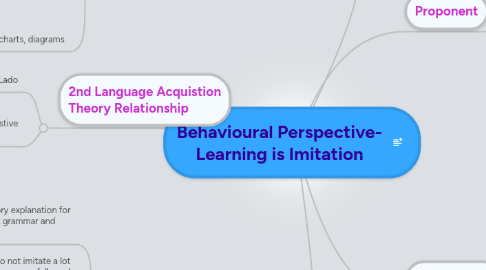Behavioural Perspective- Learning is Imitation
by Chantel Aarssen


1. 2nd Language Acquistion Theory Relationship
1.1. Brooks and Lado
1.1.1. 1940s and 1970s
1.1.2. Perspective of audioloingual teaching materials
1.1.2.1. Activities mimicry/ memorization
1.2. Linked to CAH ( Contrastive Analysis Hypothesis)
1.2.1. L1 and L2 should acquire target language if similar
1.2.1.1. Contrary if different, increase in struggle
2. Problems and Deficiences
2.1. Not satisfactory explanation for more complex grammar and constructions
2.2. Children who do not imitate a lot still acquire language as fully and rapidly
2.3. Child Confuses use of sentence structure, often asks in logical sequence of events happening
2.3.1. Not always correct order
2.4. Replace regular forms of grammar
2.5. Eventually switches to a reasoning process
3. Implications for Language Teaching
3.1. At times reluctant to transfer certain L1 patterns
3.2. immediate feedback
3.3. Focus on goals
3.4. Reinforcement
3.4.1. Prizes
3.4.2. Grades
3.4.3. Encouragement
3.5. Use of charts, diagrams
4. Proponent
4.1. 1940/1950's B.F. Skinner
4.2. Children learn from whats around them by imitiating
4.3. What is heard around them
4.4. Respond to + and - reinforcement
4.5. Stimulus -> Response -> Feedback -> Reinforcement
5. Principles
5.1. reinforcement
5.1.1. Praise came from it
